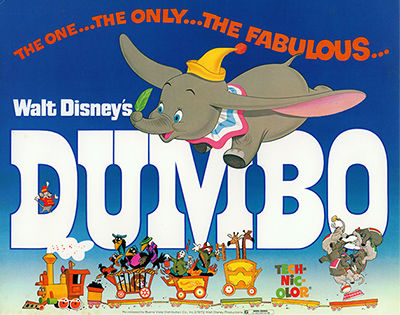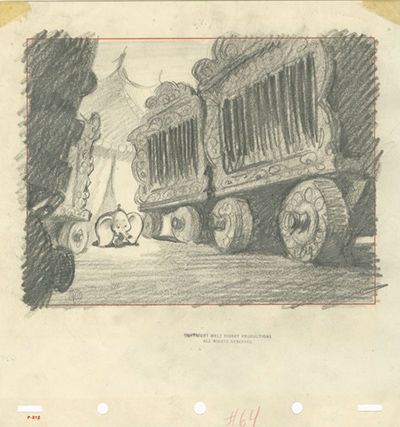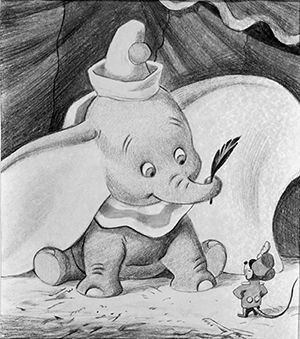
“In the inspiration of mind and spirit that go into the making of Disney picture-making one essential is clarity,” Walt Disney believed. “Failure to make clear the nature of the thing being produced is one of the surest causes of dullness and failure to learn.” After the glowing success of Snow White and the Seven Dwarfs (1937), and the artistic triumphs of Pinocchio (1940) and Fantasia (1940) that ultimately met with difficult reception, Walt had certainly learned quite a bit. And whilst a number of his artists dedicated themselves to Bambi (1942), another artistic foray, Walt took a swing at a different kind of picture. It was a feature film not as grandiose as those that preceded it, but was perhaps even more effective in emotional impact. The film was Dumbo (1941), now celebrating 75 years since its release.
Back to the Basics
Created at a time when a combination of factors put a severe limit on Walt’s ability to pour resources into new films, Dumbo was the first of a new string of features, a film made efficiently and effectively under the strictest of parameters. But Walt was not going to do anything halfway no matter the restrictions. As historian J.B. Kaufman comments, “Artistic greatness does not depend upon surface extravagance.”
So it was back to the basics. A solid and simple story that came to the Studios quite unlike most Disney subjects. Where classic fables or successful stories were gathered and sought out, Dumbo came to Disney at the urging of the manufacturer in the form of a toy “Roll-a-Book” project, in which a child could scroll through the illustrations of the story. Walt’s interest must have been piqued in a special kind of way; he acquired the rights to the story, which was subsequently published as a children’s book by the husband and wife team of Helen Aberson and Harold Pearl. Walt asked two of his key story men, Joe Grant and Dick Huemer to explore the story. It was something uncomplicated, beautifully simple, and ripe with opportunity for expansion. When Grant and Huemer came to it, they found its potential for a feature length film quite appealing. What was a charming little story became a high-flying masterpiece on the screen.
A Minimalist Approach to the Dumbo Characters
The simplicity of the drawings of Disney's Dumbo characters is a defining aspect of the film's visual style. Unlike other Disney films of the time, such as Snow White or Pinocchio, the characters in Dumbo were designed with a minimalist approach. This simplicity allowed the animators to focus on the emotional expressiveness of the characters, rather than intricate details of their designs.
Dumbo
Dumbo, the titular character, is a prime example of this simplicity. His design is incredibly basic, with a round body and simple features. His oversized ears, which are the source of his ridicule and ultimately lead to his redemption, are the most exaggerated aspect of his design. Despite his simplistic design, Dumbo's expressions and body language are incredibly emotive, making him a relatable and endearing character.
Timothy Q. Mouse
Similarly, Timothy Q. Mouse, Dumbo's companion, is designed with a straightforward, yet expressive style. His round, plump body and sharp facial features give him a distinct personality that contrasts with Dumbo's meekness.
The Circus Ringmaster
The villainous circus ringmaster is also a simple design, with a tall, thin body and exaggerated facial features that convey his greed and cruelty. Even minor characters, such as the crows who befriend Dumbo, are designed with a simple, cartoonish style that makes them instantly recognizable and memorable.
The simplicity of the character designs in Dumbo allowed the animators to focus on the emotions and storytelling of the film. The characters' simple designs made them easier to animate and allowed for more fluid movement and expressive gestures. This simplicity also made the film more accessible to a wider audience, as the designs were easy to understand and follow. The simplicity of the drawings of Disney's Dumbo characters is a testament to the power of effective visual storytelling.

Making The Most of It
“From the first time I ever saw this film, one of the things that has always struck me about it is that there’s not a wasted frame anywhere,” says Kaufman. “It’s like a perfectly constructed machine where everything dovetails together just right.” Indeed, Dumbo is a masterwork of cinema, with sophisticated cinematography and editing techniques that are still studied today. Every decision of Walt’s serves the story, a classic tale of the underdog, where the innocent Dumbo overcomes adversity in its many forms and learns to fly. It’s a story that tugs at the heartstrings, often bringing tears to audiences. And the pathos “makes the ultimate resolution that much sweeter,” as Kaufman puts it. Good storytellers earn their happy moments, and Walt does so with sublime effort.
The Seamless Construction of Dumbo
With sequences as diverse as the rousing Casey Jr. Circus Train’s journey to the circus grounds, the emotional meeting of Dumbo and his mother to the tune of “Baby Mine,” or Dumbo’s surreal visions featuring “Pink Elephants on Parade,” the picture combines beautiful imagery, appealing characterization, and delightful music. Fusing the bold artistic spirit of Walt’s previous feature films with the more concise mastery of the Silly Symphonies short cartoons, Dumbo is seamlessly constructed. Each sequence builds and transitions into the next, such as when dancing pink elephants wonderfully morph into scattered clouds over a sweet sunrise.
Mastering Dumbo Characters
One sequence that is often overlooked comes near the beginning of the film. As the circus arrives in a new town on a wet and stormy evening, a group of burly roustabouts construct the massive circus tent with aid of the elephants. Powerful and affective, the scene consumes the viewer with a montage of shots and booming music. As Kaufman puts it, “In that sequence it’s just overflowing with effects animation. You got the failing rain, you got the elephants and roustabouts trucking through the mud, you got the lanterns, the tent poles themselves and the tents. It’s a really lavish sequence right in the middle of these others that have a much brighter appearance. That’s a very canny move.” Walt and his team are so consummate in their craft as to pace the story with this crucial beat. It’s a scene full of mood and emotion, with even a touch of sentiment as the little Dumbo “assists” his mother, helping tap the massive stake into the ground with his tiny hammer.
Along with including subtleties in the film and being extremely detailed with each scene, Disney animators also spent many hours making the characters as real as possible. The animators at Disney were able to master the characters of Dumbo through a combination of traditional animation techniques, meticulous observation, and an emphasis on emotional expressiveness.
References to Real Animals
One of the key elements in mastering the characters of Dumbo was the use of live-action reference footage. Animators would study footage of live elephants and other animals to observe their movements, body language, and facial expressions. This allowed them to create more realistic and believable characters that were true to their real-life counterparts.
Using Real Emotions
In addition to live-action reference footage, animators also observed human actors to capture the emotional expressiveness of the characters. They would watch actors perform scenes and then incorporate those emotions and gestures into the animation. This attention to detail allowed the animators to create characters that were not only visually stunning but also emotionally resonant.
Giving The Drawings Personality
Another key aspect of mastering the characters of Dumbo was the use of animation principles such as squash and stretch, anticipation, and timing. These principles allowed the animators to give the characters a sense of weight and momentum, making their movements appear more fluid and natural. The exaggerated movements of characters such as Dumbo and Timothy Q. Mouse helped to convey their emotions and personalities, making them more memorable and endearing.
Giving Each Character a Purpose
Finally, the animators' dedication to storytelling was also instrumental in mastering the characters of Dumbo. Each character was designed with a specific role to play in the story, and their expressions, movements, and gestures was carefully crafted to advance the plot and evoke an emotional response from the audience.
Overall, the mastery of the characters of Dumbo by Disney animators was a result of their dedication to realism, emotional expressiveness, and storytelling. Through their hard work and attention to detail, they were able to create some of the most beloved characters in the Disney canon, who continue to captivate audiences to this day.

The Weight of World War Two
Released in the final months of 1941, Dumbo came in the middle of what Walt oncedescribed as “the toughest period in my life.” With the increasing pressures of the Second World War on the European film market, The Walt Disney Studios faced economic struggle. Changing labor sentiments in Hollywood gave birth to a strike that changed the Studios’ culture. Walt himself worked tirelessly to adjust to these many changes and twists of fate. And when the attack on Pearl Harbor finally launched the United States into the great conflict, he again stood up to a new challenge.
The resilience of Dumbo mirrors the resilience of Walt. As Kaufman describes, “He had this uncanny knack for taking a bad thing and turning it into a good thing.” Walt was ready to meet any challenge. If there were new financial constraints, then he’d deliver a feature film made along a new set of parameters, perhaps not as lavish as Pinocchio or ambitious as Fantasia, but just as glorious an experience for the audience. When future success looked anything but certain, Walt, like the character of Dumbo, learned how to fly. As the helpful Dumbo character Timothy Q. Mouse declares to the young elephant, “The very things that held you down are going to carry you up and up and up!”
Visit Us and Learn More About Disney’s Amazing History
Originally constructed in 1897 as an Army barracks, our iconic building transformed into The Walt Disney Family Museum more than a century later, and today houses some of the most interesting and fun museum exhibitions in the US. Explore the life story of the man behind the brand—Walt Disney. You’ll love the iconic Golden Gate Bridge views and our interactive exhibitions here in San Francisco. You can learn more about visiting us here.

–Lucas Seastrom
Lucas O. Seastrom is a writer, filmmaker, and contracting historian for The Walt Disney Family Museum.
